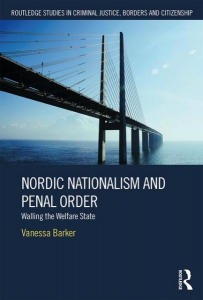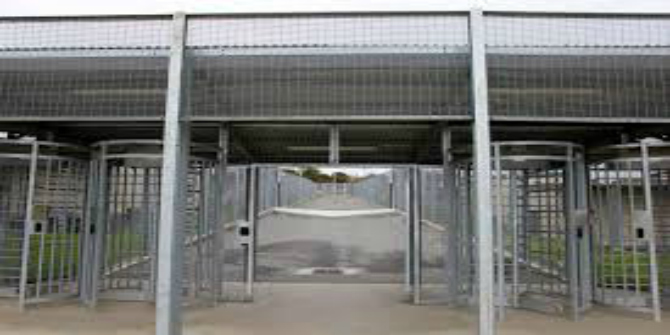In Nordic Nationalism and Penal Order: Walling the Welfare State, Vanessa Barker offers an account of the pre-conditions that allowed for the recent increase in restrictive migration policy in Sweden, as well as intensified border control and closure. Deconstructing the overly romanticised image of a welcoming welfare state through a longitudinal study, the book presents a sharp, rich and alarming analysis that will be of particular interest to those exploring the convergence of migration, crime and punishment, finds Lisa Marie Borrelli.
Nordic Nationalism and Penal Order: Walling the Welfare State. Vanessa Barker. Routledge. 2018.
Sweden as the epitome of equality and social security, as the mother of welfare states where multiculturalism and a sense of belonging still exist? In her new book Nordic Nationalism and Penal Order: Walling the Welfare State, Vanessa Barker successfully argues the contrary. Looking at the border closure of Sweden on 24 November 2015 at the peak of migration influx with 10,000 asylum seekers per week, she not only links recent developments to the interventionist welfare state, arguing against its demise. She also deconstructs the overly romanticised image of a welcoming Swedish state, which previous to the border closure presented itself as humanitarian actor, opening itself up to 163,000 asylum seekers fleeing from the war in Syria. With her critical analysis, Barker disseminates a sharp and rich account of the pre-conditions that allowed for the recent increase in restrictive migration policy as well as intensified border control and closure.
Besides naming and critically discussing the increased need for security and thus fear of migrant overload in Sweden, this book goes beyond a simplified causal relation between the ‘crisis’ and ostracising state actions. Instead, it links the recent border closure back to the longstanding political and societal context and the workings of the welfare state. This work deconstructs Sweden as a nation preliminarily focused on care and equality, instead highlighting the discriminatory aspects of the strongly developed welfare state. Baker claims that one crucial causal mechanism is the nationalistic perspective of the Swedish welfare state – a perspective highly relevant to understanding reactions to migration in a more longitudinal and coherent way.
Throughout the six chapters in which this book is divided, Barker presents an in-depth study of Sweden using a case study method. Here a single recent event (the border closure) is set in the context of historical developments around the Swedish welfare state, penal order and migration control. Chapter One introduces relevant theories which advance Barker’s understanding of ‘penal nationalism’. This makes use of coercive tools, such as expulsion and detention, ‘to respond to mass mobility’ (7). It further includes two dimensions: the ‘structural capacity to [(re)produce] political authority’, as well as the ‘communicative capacity to classify wrongdoing and membership’ (7).
 Image Credit: Öresund bridge (Maria Eklind CC BY SA 2.0)
Image Credit: Öresund bridge (Maria Eklind CC BY SA 2.0)
In Chapter Two, Barker paves the road for the analysis by examining the internal logic of Sweden’s welfare state. It was and remains a national project, based on a feeling of security and safety; however, this only includes nationals. Following this, Chapter Three closely studies the production of the demos, revealing categories of who does and does not belong. Chapters Four and Five focus on the ‘penalisation of migration control in the absence of criminal offences’ (131). This penal power, between punishment and exclusion, makes the system successful. Indeed, ‘penal power communicates wrongdoing that necessitates and justifies a state response’ (131). Chapter Six serves to ‘revisit the relationship between punishment and welfare’ (133), breaking with the idea that generous welfare states automatically pursue milder sanctions.
As the Swedish example shows, besides a ‘global reputation for openness toward asylum seekers and refugees’ (133) and a milder approach to punishment, migrants still face ‘repressive means of control’ (133). Nationalism and penal power are intertwined, since this power (re)produces national interests. Here, two narratives are introduced, which ‘emerged from welfare state formation, one based on civic belonging, and the other based on ethnocultural belonging’ (137). The former allows Sweden to be an inclusive society with a generous welfare state. However, ethnocultural belonging enables some individuals to be easily excluded from the demos, limiting their ability to access the offerings of the welfare state.
Barker argues that the emerging penal nationalism allowed the Swedish state to react to migration influx the way it did: by closing the borders and increasing the focus on deporting individuals. With this intensified control, the state was able to reassert power, since the number of incoming migrants dropped. At the same time, governing strategies of control have ‘destabilising effects in part because they impose penal harm and insecurity on others in ways that violate the equality principle so central to democracies’ (138). This penal harm includes punishment without criminal offence, such as migrant detention; hence, crime and punishment are decoupled.
Besides the overall relevance of this work, Barker makes three crucial points. First, she highlights how violence is prevalent in the entire governing system and law, taking a previously studied example on the eviction of Roma settlements in Sweden and their deportation. This opens up the floor to further research on other areas where such ‘benevolent violence’ –seemingly good state intentions which have violent outcomes – is practised, as well as the possibility of connecting Barker’s findings to more ethnographic studies that can profit from her analysis.
Second, penal nationalism not only assures national security, but also social security for citizens alone – a crucial factor of the welfare state. Social capacity was, according to Barker, in the end the key element for negative and punitive measures, culminating in the border closure. The welfare state thus distinguishes between those worthy through their membership and the ones who are not. Equality is only available for those included, to the expense of the non-included.
It is clearly argued that it is less the retraction of the welfare state than the welfare state itself that upholds and drives penal order (134), leading to the third key theme in this book. Barker’s critical view and theoretical development of penal nationalism substantially question our understanding of recent developments. Her analysis is able to unlink recent assumptions from the discourse of ‘crisis’, and thus a moment of exception, to demonstrate a more long-term, and to some extent strategic, shift towards restrictive migration policies. Linking penalism, welfare state and migration explains the criminalisation of migrants, which could only happen because the state brought back a moral value to the sorting process between those deemed worthy and those not.
Barker creates a refreshing, as well as alarming, analysis of recent migration policies, uncovering a much longer and steady development of punitive policies in the welfare state. Though dense in its analysis, this work is accessible due to various concrete examples. It enriches not only the theoretical sphere of academia with a case study that is detailed and innovative in nature, but also gives a concrete macro-analysis. Generally, this book addresses any reader who is interested in the convergence of migration, crime and punishment. It is a relevant work, meeting its promise to link the Swedish border closure to previous governmental and societal developments.
Lisa Marie Borrelli is a research assistant at the Institute of Sociology at Bern University, Switzerland. She has conducted extensive ethnographic fieldwork on border police, police and migration offices and how those street-level bureaucrats detect, detain and deport irregularised migrants throughout six Schengen Member States, including Italy, Switzerland, Germany, Sweden, Lithuania and Latvia. Her recent works include the article‘Whisper down, up and between the lanes – Exclusionary policies and their limits of control in times of irregularized migration’ and ‘The Creativity of Coping: Alternative Tales of Moral Dilemmas among Migration Control Officers’, co-written with Annika Lindberg.
Note: This review gives the views of the author, and not the position of the LSE Review of Books blog, or of the London School of Economics.


 Find this book:
Find this book: 





1 Comments